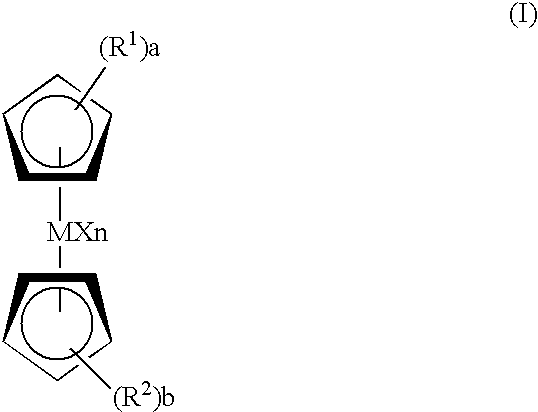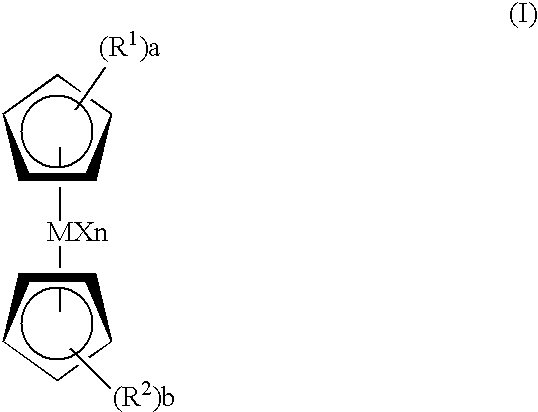Catalyst for bulk polymerization
a polymerization catalyst and polymerization reaction technology, applied in physical/chemical process catalysts, organic compound/hydride/coordination complex catalysts, chemical/physical processes, etc., can solve the problems of high polymerization reaction velocity, difficult control of the bulk polymerization process, laborious and time-consuming process, etc., and achieve stable bulk polymerization
- Summary
- Abstract
- Description
- Claims
- Application Information
AI Technical Summary
Benefits of technology
Problems solved by technology
Method used
Image
Examples
example 1
[0103] 100 parts by weight of ethyl acrylate and 0.05 part by weight of ruthenocene as a metal catalyst were charged into a flask equipped with an agitator, a nitrogen gas introduction tube, a thermometer and a reflux cooling tube. The flask contents were heated to 70.degree. C. while introducing nitrogen gas into the flask.
[0104] Subsequently, 6 parts by weight of .beta.-mercaptopropionic acid satisfactorily purged with nitrogen gas was added to the flask contents under agitation. Cooling and heating were performed for two hours after the addition of the .beta.-mercaptopropionic acid so that the temperature of the flask contents under agitation was maintained at 70.degree. C. Further, another 6 parts by weight of .beta.-mercaptopropionic acid satisfactorily purged with nitrogen gas was added to the flask contents under agitation. Reaction was carried out for four hours after the further addition of the .beta.-mercaptopropionic acid with further cooling and heating so that the tempe...
example 2
[0111] 100 parts by weight of methyl acrylate, 10 parts by weight of trimethylolpropane triacrylate and 0.02 part by weight of zirconocene dichloride as a metal catalyst were charged into a flask equipped with an agitator, a nitrogen gas introduction tube, a thermometer and a reflux cooling tube. The flask contents were gently heated to 80.degree. C. while introducing nitrogen gas into the flask.
[0112] Subsequently, 50 parts by weight of 3-mercaptopropyl(trimethoxy)sil-ane satisfactorily purged with nitrogen gas was added to the flask contents under agitation. Reaction was carried out for eight hours after the addition of the 3-mercaptopropyl(trimethoxy)silane while cooling and heating so that the temperature of the flask contents under agitation was maintained at 80.degree. C.
[0113] After the above reaction, the reaction product was cooled to room temperature. Then, 20 parts by weight of a benzoquinone solution (95% THF solution) was added to the reaction product to thereby termina...
example 3
[0119] 80 parts by weight of styrene, 20 parts by weight of perfluorooctylethylene and 0.1 part by weight of titanocene dichloride as a metal catalyst were charged into a flask equipped with an agitator, a nitrogen gas introduction tube, a thermometer and a reflux cooling tube. The flask contents were heated to 80.degree. C. while introducing nitrogen gas into the flask.
[0120] Subsequently, 10 parts by weight of 2-mercaptoethanol satisfactorily purged with nitrogen gas was added to the flask contents under agitation. Reaction was carried out for two hours after the addition of the 2-mercaptoethanol while cooling and heating so that the temperature of the flask contents under agitation was maintained at 80.degree. C.
[0121] Thereafter, 10 parts by weight of 2-mercaptoethanol was added to the flask contents under agitation, and further reaction was performed for two hours. Moreover, 20 parts by weight of 2-mercaptoethanol was added to the flask contents under agitation, and still furth...
PUM
| Property | Measurement | Unit |
|---|---|---|
| temperature | aaaaa | aaaaa |
| temperature | aaaaa | aaaaa |
| temperature | aaaaa | aaaaa |
Abstract
Description
Claims
Application Information
 Login to View More
Login to View More - R&D
- Intellectual Property
- Life Sciences
- Materials
- Tech Scout
- Unparalleled Data Quality
- Higher Quality Content
- 60% Fewer Hallucinations
Browse by: Latest US Patents, China's latest patents, Technical Efficacy Thesaurus, Application Domain, Technology Topic, Popular Technical Reports.
© 2025 PatSnap. All rights reserved.Legal|Privacy policy|Modern Slavery Act Transparency Statement|Sitemap|About US| Contact US: help@patsnap.com



